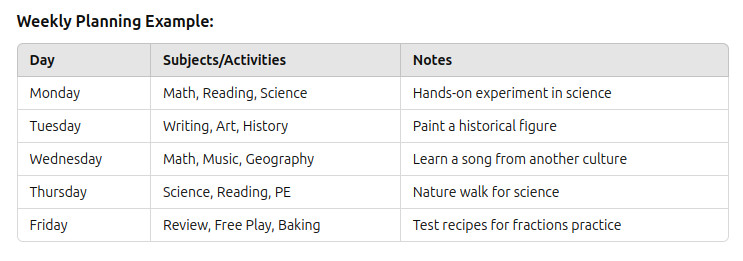Scheduling for Success:
Simplifying Homeschool Routines for Your Family
Simplifying Homeschool Routines for Your Family

Table of Contents
1. Introduction
- Why Scheduling Matters
- What’s Inside
2. Creating a Schedule That Works
- Balancing Structure and Flexibility
3. Daily and Weekly Templates
- Tips for Effective Time Management
4. Personalized Scheduling Page
- Printable Template for Each Child
5. Final Thoughts
- Encouragement to Embrace the Process
1. Introduction
Why Scheduling Matters
Homeschooling offers unparalleled flexibility, but without some level of structure, days can spiral into chaos. A well-thought-out schedule helps ensure you meet educational goals while leaving room for creativity, rest, and the inevitable unexpected moments. After homeschooling seven children across three continents, trust me—it’s worth the effort.
What’s Inside
In this guide, you’ll find:
- Tips on how to create a balanced schedule tailored to your family.
- Templates for daily and weekly planning.
- A customizable scheduling page to print and adapt for each child.
2. Creating a Schedule That Works
Balancing Structure and Flexibility
No two families are alike, so no single schedule works for everyone. Here are some guiding principles to help you craft one that works:
- Start with Priorities
- What are your top educational goals this year?
Include non-academic activities like sports, music, or faith-based studies.
- What are your top educational goals this year?
- Start with Priorities
- Block Out Non-Negotiables
- Schedule fixed commitments first, like doctor’s appointments or group classes.
- Block Out Non-Negotiables
- Plan Around Your Family’s Rhythm
- Are your kids early birds or night owls?
- Schedule the hardest tasks for when they’re most alert.
- Plan Around Your Family’s Rhythm
- Leave Wiggle Room
- Life happens. Keep afternoons or Fridays lighter for catch-up or enrichment.
- Leave Wiggle Room
Example Daily Schedule Outline:
- Morning (9:00 – 12:00): Core subjects like math, reading, writing.
- Lunch and Break (12:00 – 1:00): Recharge time for everyone.
- Afternoon (1:00 – 3:00): Science, history, art, or field trips.
- Late Afternoon (3:00 – 5:00): Free play, chores, or extracurricular activities.
3. Daily and Weekly Templates
Tips for Effective Time Management
- Batch Similar Activities: Teach the same subject to multiple children when possible.
- Set Timers: Keep kids (and yourself) on task with short, focused work sessions.
- Rotate Roles: Let kids take turns being the “timekeeper” or “task leader” for added engagement.


Final Thoughts
Schedules are tools, not taskmasters. Some days will go perfectly, while others may feel like herding cats. That’s okay—homeschooling is about progress, not perfection. Embrace the process, adjust as needed, and remember that the best schedule is the one that works for your family.
